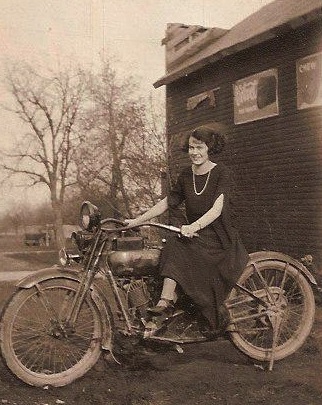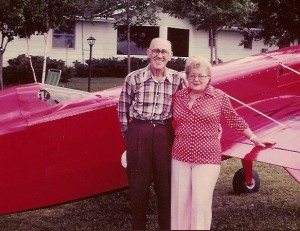
Photo by Jim Cunningham
Wow—the National Aviation Hall of Fame enshrinement ceremony really did feel like an aviation version of the Academy Awards. You couldn’t swing a cat without hitting a pilot, astronaut, general, or aerospace executive. Biographical videos narrated by Nick Clooney. Spotlights, cameras, and teleprompters. Two Jumbotrons. At the rehearsal, I was standing next to a gentleman who I thought looked a lot like David Hartman (of “Good Morning America” and other TV series and documentaries). And it turned out that he was David Hartman, the emcee for the event. (His IMDB profile describes him as “genial” and “toothsome,” and I can attest firsthand that both adjectives are accurate.)
At the dinner, I was seated with air racing legend Bill Brennand, historian and author Jim Cunningham, and EAA‘s Jim Casper. Bill got his start in racing as a teenager when he placed first at the 1947 National Air Races flying one of Uncle Witt’s planes (which is an incredible story in itself). I got to hear some amazing stories, including some that Bill shared in his introductory speech.
As for my acceptance speech, I could see that it was too long and needed to be trimmed down. For example, I could have spent the entire speech talking about the oversized role that motorcycles have played in family lore. Uncle Witt demonstrated his early love of motorized vehicles by purchasing a Harley-Davidson motorcycle in his late teens. And a motorcycle engine was the modest power source for his first airplane, a home-built that he constructed while still in high school and dubbed the “Hardly Ableson” in reference to its limited performance capability.
The interest in motorcycles extended to Uncle Witt’s older sister, Marie (my grandmother). My perception of Grandma closely corresponded to the stereotypical image that you would expect of a former English teacher. So you could imagine my surprise when shown photos of my schoolmarm grandmother astride her brother’s motorcycle.
The Harley-Davidson’s role in my family history was cemented further when Uncle Witt became friends with a fellow biker, Perry Anderson. Perry was understandably smitten with Marie. (Who can resist a biker chick?) I’m told that the two of them would ride together, with Marie in the sidecar. Before long, Perry became Marie’s husband, Steve’s brother-in-law, and eventually, my grandfather. One can’t help but think that cycling helped bring my grandparents together.
Uncle Witt and Grandpa ended up buying a WW I surplus airplane (a Standard J-1). It sounds like the two of them did pretty much what any young men might do with their own airplane in the 1920s: plane rides for the locals, stunts and barnstorming, towing advertising banners. A lot of their income to keep the plane operating came from appearances at county fairs, where local farmers lined up to take their spouses in a genuine airplane ride. Two passengers at a time could fit in the wide front cockpit of the plane. Uncle Witt once told of a portly couple who wanted a ride. They did fit in the front seat, but he was genuinely worried whether the tired old plane could get off the ground.
Grandpa knew how to make a dramatic entrance. When Grandma was attending Carroll College in Waukesha, Grandpa would sometimes fly into an adjoining pasture on Friday afternoons to take her back to Byron for the weekend. But after a while, Grandpa abandoned the life of an aviator to become a welding engineer, while Uncle Witt went on to manage the airport in Oshkosh, WI and to construct his first home-built racing plane, Chief Oshkosh.
As for Uncle Witt’s motorcycle, it ended up in my great-grandmother’s backyard garage, gathering dust in the corner. During my father’s summer visits as a youngster, the old motorcycle was an irresistible attraction. He recalls the fun of sitting astride the old wreck and making raucous engine revving noises, as any kid would do. The ancestral love for motorcycles came to fruition for Dad in his teenage years when he acquired a Cushman motor scooter. And from the photographic evidence, it appears that he did his own share of acrobatics.
The evening was a great opportunity for storytelling about Uncle Witt’s achievements in aviation, but I was struck by how many people had recollections of about him as a person. Everyone seemed to have a memory about how this good-natured man was generous with his time. Eddie Saurenman (whose replica of Uncle Witt’s Chief Oshkosh is displayed at the Florida Air Museum) told me about how as a teenager, he exchanged letters with him. This feeling was expressed by racing giant Tony LeVier when he gave Uncle Witt a copy of his biography with this handwritten inscription:
To Steve Wittman, the grand old guy of air racing and a great booster of aviation.
I shall always remember Steve Wittman for being a wonderful sport and a gentle and kind friend.
You have much to be proud of, Steve, and I don’t say it to be clever. It’s a fact that you are the Grand Daddy of air racing besides being a leader in a tireless effort to sell private aviation.
Your old racing pal, Tony LeVier.
[Visit this page for links to articles about the NAHF event.]







